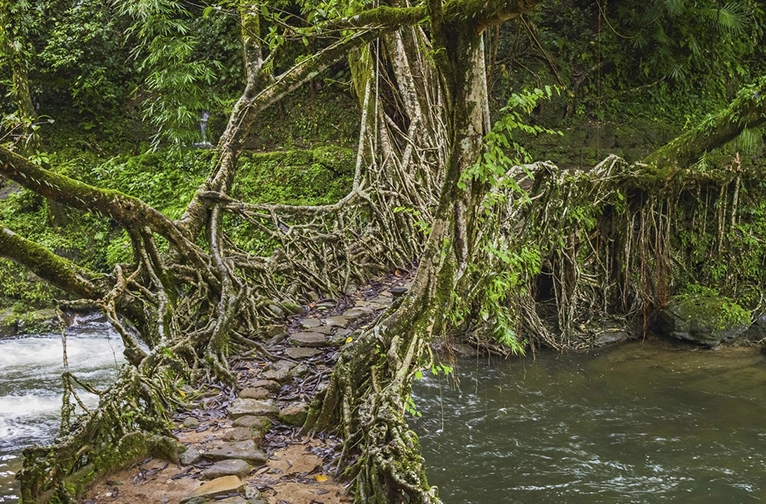Bamboo Barrier: A Green Solution to Landslides on Gap Road

Landslides have been a persistent threat to the Gap Road stretch, posing significant risks to both human life and property. In a promising development, the Assembly Committee on Environment has directed the concerned departments and the National Highways Authority of India (NHAI) to explore a nature-based solution: planting bamboo along the vulnerable areas. This innovative proposal aims to prevent future landslides while simultaneously addressing the food security concerns of elephants in the region. The Problem: Landslides on Gap Road Gap Road, notorious for its susceptibility to landslides, has been a cause for concern for years. The road’s location, coupled with the region’s geological conditions, makes it particularly vulnerable to soil erosion and slope instability. Landslides on this stretch have led to loss of life, property damage, and disruptions in transportation, impacting the lives of countless people. The Bamboo Solution: A Green Shield The proposed plan to plant bamboo along the Gap Road stretch is a commendable step towards mitigating the landslide risk. Bamboo, known for its robust root system, has the potential to reinforce the soil and prevent erosion. The deep penetration of bamboo roots into the soil can significantly enhance the soil’s stability, acting as a natural barrier against landslides. Moreover, the initiative extends beyond landslide prevention. By introducing bamboo and reed bamboo, the project aims to create a sustainable food source for elephants in the region. This dual benefit underscores the holistic approach of the proposal. A Collaborative Effort The successful implementation of this project requires a collaborative effort involving multiple stakeholders. The Forest Department, with its expertise in ecology and wildlife conservation, will play a crucial role in identifying suitable bamboo species and ensuring their proper cultivation. The Social Forestry wing can contribute to the project by providing technical guidance and support. The Kerala State Biodiversity Board’s role will be vital in assessing the environmental impact and ensuring the project aligns with biodiversity conservation goals. NHAI’s involvement is essential for the execution of the project along the road stretch. Scientific Study and Implementation Before embarking on a large-scale plantation, NHAI will conduct a comprehensive scientific study to evaluate the feasibility and effectiveness of the bamboo barrier. This study will involve soil analysis, slope stability assessment, and identification of suitable bamboo species. Once the study yields positive results, a detailed project plan will be formulated, outlining the plantation areas, the required quantity of bamboo saplings, and the timeline for implementation. Benefits Beyond Landslide Prevention The bamboo plantation project offers several additional benefits: Challenges and Considerations While the bamboo plantation project holds immense promise, it is essential to address potential challenges and considerations: Conclusion The proposal to plant bamboo along the Gap Road stretch is a visionary step towards addressing the landslide problem while contributing to ecological restoration and community development. By combining scientific expertise, collaborative efforts, and community participation, this project can become a model for sustainable land management and disaster risk reduction. As the project progresses, it is essential to monitor its impact closely and make necessary adjustments to ensure its long-term success.
Bamboo Plantations: A Green Gold Rush Against Climate Change

The world is grappling with the pressing issue of climate change. As the impacts of global warming become increasingly evident, the need for sustainable solutions has never been more critical. One such solution lies in the cultivation of bamboo, a remarkable plant often hailed as “green gold.” This blog post delves into the myriad benefits of bamboo plantations, exploring how they can contribute to mitigating climate change, bolstering economic growth, and preserving our planet for future generations. Bamboo: Nature’s Climate Change Champion Bamboo, a fast-growing grass, possesses exceptional qualities that make it a formidable ally in the fight against climate change. Its rapid growth rate is unparalleled, with some species capable of reaching maturity within a few months. This rapid growth translates into an extraordinary carbon sequestration capacity. Bamboo absorbs carbon dioxide from the atmosphere at a significantly higher rate than many trees, helping to reduce greenhouse gas emissions. Beyond carbon sequestration, bamboo plays a crucial role in soil conservation. Its extensive root system binds the soil together, preventing erosion and preserving precious topsoil. This is particularly important in regions prone to deforestation and landslides, where bamboo can help stabilize vulnerable ecosystems. Additionally, bamboo plantations contribute to water conservation by reducing runoff and improving water infiltration. A Versatile Resource with Endless Possibilities Bamboo’s versatility is another key factor driving its potential as a sustainable solution. It is a renewable resource that can be used in a wide range of applications, from construction and furniture to textiles and paper. By substituting traditional materials with bamboo, we can reduce our reliance on non-renewable resources and minimize environmental impact. One of the most promising applications of bamboo lies in the construction industry. Bamboo-based building materials offer a sustainable and cost-effective alternative to conventional materials such as steel and concrete. Bamboo structures are known for their strength, durability, and earthquake resistance. Moreover, the production of bamboo building materials generates fewer greenhouse gas emissions compared to traditional construction methods. Another area where bamboo is making a significant impact is in the fight against plastic pollution. Bamboo-based products, such as biodegradable cutlery, straws, and packaging, offer eco-friendly alternatives to single-use plastics. By reducing plastic consumption, we can help protect marine life and reduce the amount of plastic waste ending up in landfills. Economic Opportunities and Social Impact The cultivation of bamboo can also generate substantial economic benefits. Bamboo plantations can create employment opportunities in rural areas, providing livelihoods for local communities. The development of bamboo-based industries can stimulate economic growth and reduce poverty. Furthermore, bamboo farming can empower women and marginalized groups, promoting gender equality and social inclusion. Challenges and Opportunities While bamboo offers immense potential, there are challenges to overcome. The lack of awareness about bamboo’s benefits and the limited availability of processing facilities can hinder its widespread adoption. However, with increasing government support, research and development, and private sector investment, these challenges can be addressed. To fully realize the potential of bamboo, it is essential to promote sustainable bamboo cultivation practices. This includes avoiding monoculture plantations, preserving biodiversity, and ensuring fair labor practices. By adopting responsible cultivation methods, we can maximize the positive impacts of bamboo while minimizing negative externalities. Conclusion Bamboo plantations offer a compelling vision for a sustainable future. By harnessing the remarkable properties of this versatile plant, we can mitigate climate change, conserve resources, and create economic opportunities. It is time to embrace bamboo as a cornerstone of our efforts to build a greener, more resilient world. By investing in bamboo research, development, and promotion, governments, businesses, and individuals can contribute to a bamboo-led transformation. Let us work together to unlock the full potential of this extraordinary plant and create a better future for generations to come.
Living Root Bridges of Meghalaya: Nature’s Marvel or Human Ingenuity?

Nestled amidst the lush green hills of Meghalaya, India, lies a marvel of nature and human ingenuity: the living root bridges. These extraordinary structures, crafted over centuries by the indigenous Khasi and Jaintia tribes, are a testament to their deep-rooted connection with the environment. With their inclusion on the tentative UNESCO World Heritage Site list, these bridges have garnered global attention, captivating the hearts of nature enthusiasts and explorers alike. The Enigma of Living Root Bridges How is it possible that bridges can grow from the earth? The answer lies in the ingenious techniques employed by the local tribes. By carefully guiding the aerial roots of rubber fig trees (Ficus elastica) over bamboo scaffolds, they cultivate living, breathing bridges that become stronger and more resilient with time. These bridges are not merely pathways; they are intricate ecosystems that support biodiversity, providing homes for various flora and fauna. A Symphony of Nature and Human Effort The construction of a living root bridge is a multi-generational endeavor, requiring patience, skill, and a deep understanding of the forest’s dynamics. The community plays a vital role in nurturing these bridges, ensuring their longevity and sustainability. It’s a testament to the harmonious coexistence of humans and nature, a philosophy deeply ingrained in the culture of Meghalaya. Beyond Aesthetics: The Ecological Significance While the living root bridges are undoubtedly breathtaking, their ecological importance cannot be overstated. These bridges serve as corridors for wildlife, facilitating movement through the dense forests. They also contribute to soil conservation, preventing erosion and preserving the delicate ecosystem. Moreover, the bridges play a crucial role in maintaining water quality by filtering pollutants and regulating water flow. A Cultural Tapestry The living root bridges are more than just engineering marvels; they are an integral part of the local culture. The Khasi and Jaintia tribes have a profound reverence for nature, and the bridges symbolize their harmonious relationship with the environment. The construction and maintenance of these bridges are often accompanied by traditional rituals and ceremonies, reinforcing their cultural significance. Tourism and Conservation The growing popularity of living root bridges has led to an influx of tourists, eager to witness this natural wonder firsthand. While tourism can generate economic benefits for the local community, it’s essential to manage it sustainably to protect the bridges and their surroundings. Responsible tourism practices, such as guided tours, eco-lodges, and community-based initiatives, can help ensure the long-term preservation of these precious ecosystems. Challenges and Opportunities Despite their resilience, living root bridges face challenges such as climate change, deforestation, and increased foot traffic. It is imperative to develop comprehensive conservation plans to address these threats and safeguard the future of these iconic structures. Collaboration between government agencies, local communities, and environmental organizations is crucial for the successful implementation of conservation efforts. Conclusion The living root bridges of Meghalaya stand as a testament to the ingenuity of the human spirit and the power of nature. These remarkable structures are not only architectural marvels but also vital components of the region’s biodiversity and cultural heritage. As we marvel at their beauty, let us also commit to preserving these precious ecosystems for generations to come.
